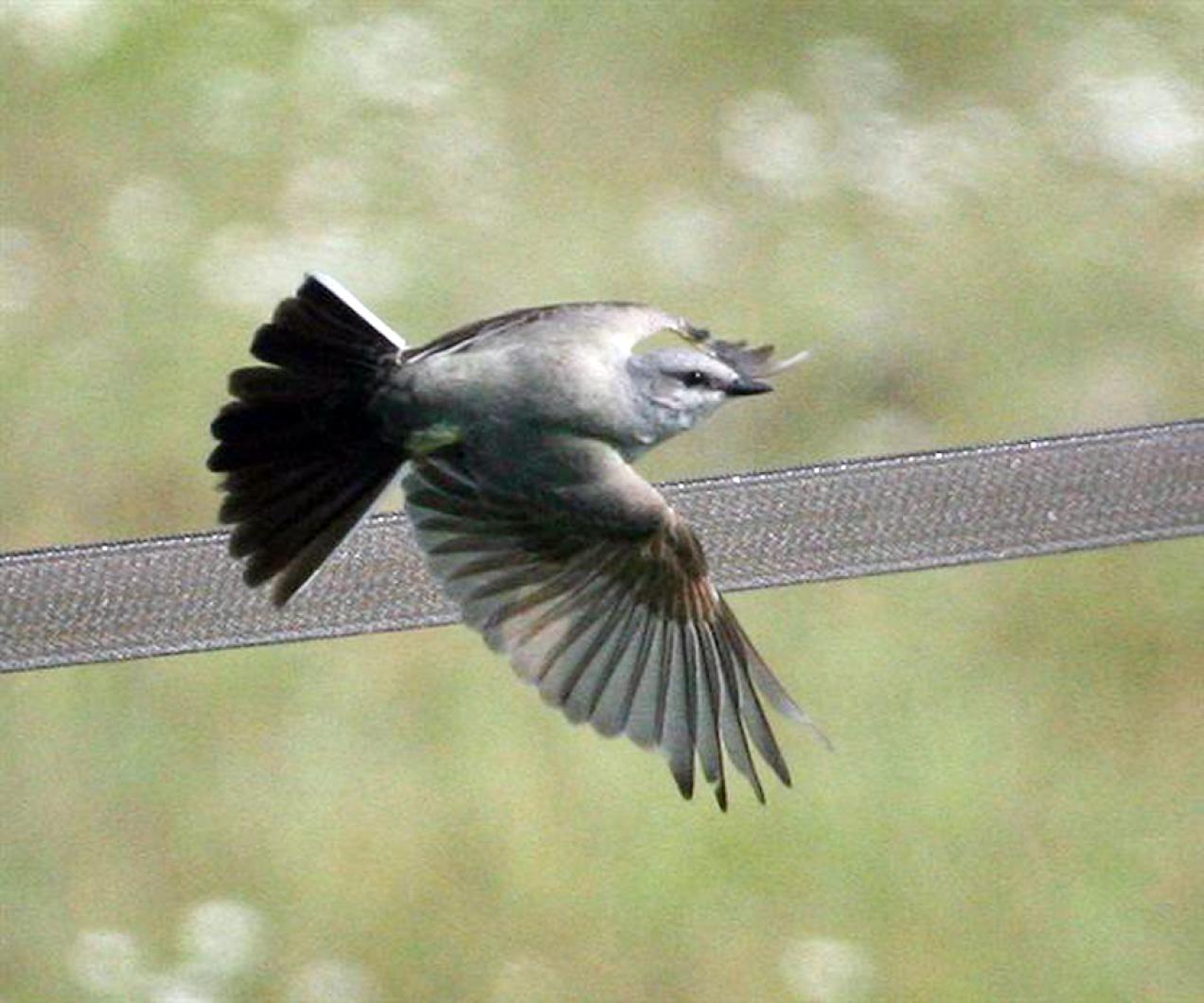A bird species that normally visits the Vineyard in the fall surprised Vineyard birders by appearing on Island on May 29. Jenifer Strachan feeds birds at her Waldron’s Bottom home and has a keen ear for bird songs and calls, thanks to her grandfather’s training. On May 29 she was inside and heard a one-note call that she was not familiar with. Slowly she ventured out on her deck and looked around. In an oak tree about 20 feet away a bird was perched, all fluffed up and looking, in Jenifer’s eyes, very confused. Jenifer knew she had not seen this bird before. She was able to return into the house and fetch her binoculars and study all the field marks of the mystery bird. Hitting the field guides and the Internet, she determined the bird in the oak tree was a western kingbird.
Skip ahead to June 4. Matt Pelikan was at the Sheriff’s Meadow property off Old County Road. As he approached the fences for the paddocks at Misty Meadows he spotted a kingbird. On closer observation he determined it was a western kingbird. Matt called other Vineyard birders, and many of us had a chance to see the bird and Lanny McDowell was able to photograph it.
The first western kingbird recorded in Massachusetts, according to The Birds of Massachusetts by R. Veit and W. Petersen, occurred in Hyannis in 1887. The first record on the Vineyard was in November 1921. The western kingbird breeds mostly west of the Mississippi River although it is moving eastward. This kingbird is a regular fall migrant on the Vineyard as it heads to Georgia, Florida and Central America for the winter. Although this kingbird usually migrates in flocks, we usually only see single birds, although there is one record of four, and another of six individuals visiting the Vineyard in the fall. There are other early records for the western kingbird on the Vineyard, one on June 21, another on July 9, and another on August 15, but none as early as May 29!
The great-crested flycatcher, which is a common nester on the Vineyard, is the only bird that one might confuse with the western kingbird. Both have gray breasts and yellow bellies. The great-crested flycatcher has a rufous under-tail where the western kingbird’s is black with white outer feathers. The great-crested flycatcher, true to its name, sports a crest, while the western kingbird has a rounded head and a much smaller bill than the great-crested. Congratulations, Jenifer, for knowing you were seeing something unusual!
Bird Sightings
The western kingbird seen first on May 29 and then again on June 4, both times in West Tisbury, is the hottest news item.
Sad news comes from Chappaquiddick. The pair of ospreys that laid their eggs on the dunes lost the eggs to predators. We are not surprised, as this behavior was definitely aberrant. The only other osprey to have laid eggs on the ground (actually on a lobster pot) in the U.S. was on Gardiners Island in Long Island Sound, where there are no ground predators. I have seen an osprey nest on the ground in the Bahamas, but again it was on a cay with no ground predators.
And speaking of ospreys, Penelope, who started from French Guiana on April 2, finally made it to Massachusetts on June 6. She was close to Worcester and we hoped her next stop would be the Vineyard; however, she had other plans as she headed west toward Springfield.
Sue Sellers from Edgartown saw an odd happening. A hen turkey marched through her yard with 12 young turkeys following closely behind. At the end of the train was another adult hen turkey. Every now and again the mother turkey would run around her brood and kick at and try to drive the other hen away from her chicks to no avail. I checked with Gus Ben David of the World of Reptiles and Birds and discovered that if a hen loses her own brood, she will try to adopt another hen’s youngsters. Frequently after the mother is unable to drive the chickless hen away, she allows the chickless hen to help raise the brood! Hmm, not a bad deal.
Larry Hepler heard a yellow-billed cuckoo at Quansoo on June 2. Shirley Miller was driving down Old Indian Trail on Chappaquiddick when she spotted three American woodcocks in the road bouncing up and down as they are wont to do. Sally Segal had an indigo bunting at her Longview Road feeder. It is getting late for migrants, so Sally may have a nesting pair around.
John Liller, his wife, Kim Kastler, and son mixed birding and fishing at Wasque and Brine’s Pond and vicinity on Chappaquiddick on June 4. Their best birds were a horned lark pair, eastern bluebird in nest box, barn swallows collecting nesting material, pine warbler, common yellowthroat, Cooper’s hawk, ruby-throated hummingbird, belted kingfisher, eastern wood pewee, eastern kingbird building a nest, tufted titmouse singing, and an ovenbird.
Please report your bird sightings to the Martha’s Vineyard Bird Hotline at 508-627-4922 or e-mail birds@mvgazette.com. Susan B. Whiting is the coauthor of Vineyard Birds and Vineyard Birds II. Her Web site is vineyardbirds2.com.




Comments
Comment policy »